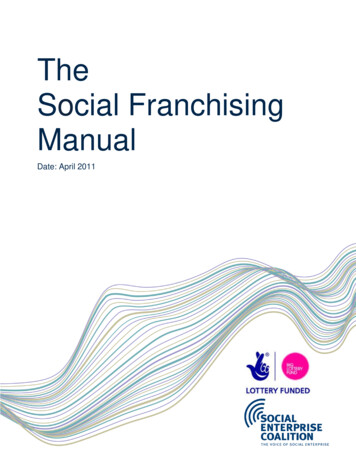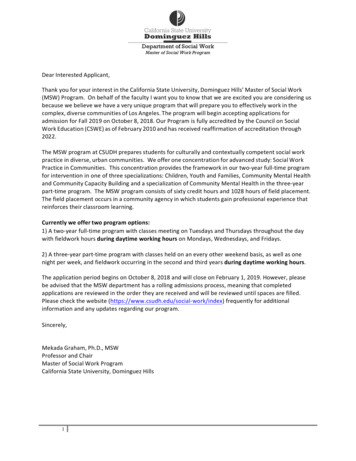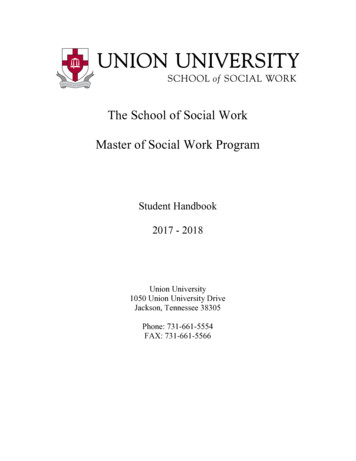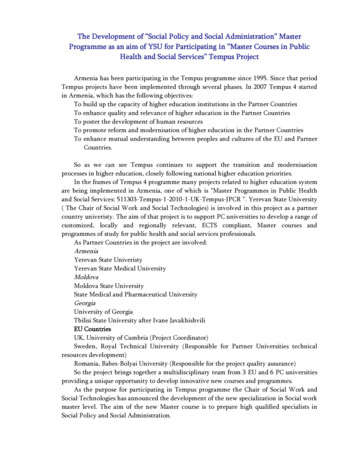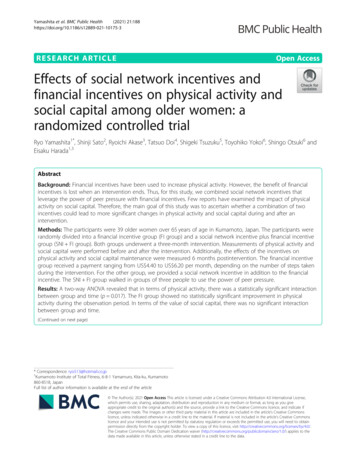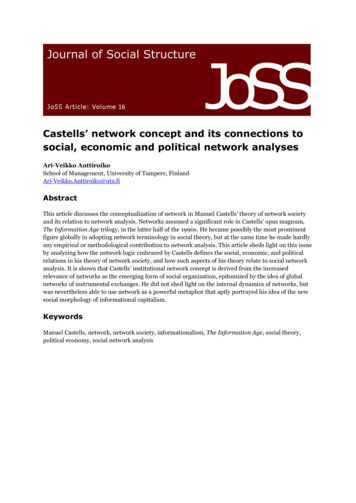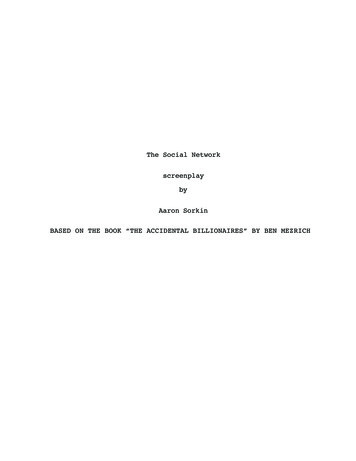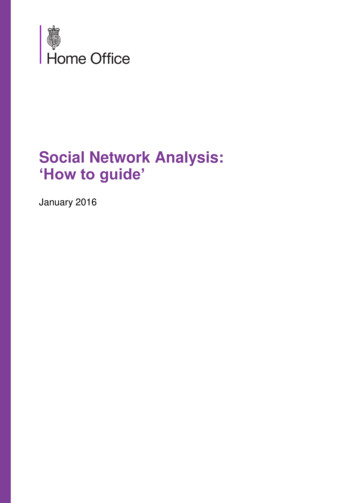
Transcription
Social Network Analysis:‘How to guide’January 2016
ContentsTable of ContentsWhat is social network analysis? . 3What can social network analysis do for me? . 3What will I get at the end of it? . 3What are the limitations? . 5What do I need to complete the analysis?. 6Approach . 7Resource A: Possible data collection process. 9Resource B: Possible analytical approach . 13Disclaimer: ‘The views expressed in this report are those of the authors, not necessarily thoseof the Home Office (nor do they represent Government policy).’Social Network Analysis: ‘How to’ guide2
This guide is intended to help local areas and police forces use intelligence data to undertakesocial network analysis of their local gang issues.What is social network analysis?The aim of social network analysis is to understand a community by mapping the relationshipsthat connect them as a network, and then trying to draw out key individuals, groups within thenetwork (‘components’), and/or associations between the individuals.A network is simply a number of points (or ‘nodes’) that are connected by links. Generally insocial network analysis, the nodes are people and the links are any social connection betweenthem – for example, friendship, marital/family ties, or financial ties.What can social network analysis do for me?Social network analysis can provide information about the reach of gangs, the impact of gangs,and gang activity. The approach may also allow you to identify those who may be at risk ofgang-association and/or being exploited by gangs.Network analysis can be completed ‘qualitatively’ – that is, with diagrams drawn by hand. Thisguide details a more systematic approach to network analysis. Particular benefits of this include: Practicality: The approach provides an objective, replicable representation of thecommunity which is described in the intelligence data. It does not need thoseundertaking it to have knowledge of a gang or extensive analytical training. Wider applications: It also provides a systematic understanding of local gang issuesand the relationship with those who may be seen as gang-associated. This has potentialapplications for producing community impact statements and particular interventions(e.g. gang injunctions). Targeting responses: The process of mapping a gang may allow action to be moreclosely tailored to specific individuals – for example, differentiating between ‘core’ gangmembers and peripheral members. This may increase the effectiveness of work totackle gangs and gang culture. Multiple uses: The data collection process can be completed centrally and the overallnetwork analysis provided to local teams. The networks can then be examined /manipulated to answer particular local questions as required. This may be more efficientthan producing different analytical products for each local issue.What will I get at the end of it?The technique will generate diagrams that will show the relationships between individuals thatare contained in your data, this could include: criminal links, social links, potential feuds, etc.Figure 1 below gives an example – to note the diagrams can include names, pictures andfurther details of individuals as required.Social Network Analysis: ‘How to’ guide3
Figure 1: Example output (note: numbers here indicate individuals).It is also possible to produce statistical analysis of the networks which can help you to define aproblem, and to explore the roles of particular individuals in the networks (see table 1 for somekey statistics). This can be completed automatically by the social network analysis software.Social Network Analysis: ‘How to’ guide4
Table 1: Key network statisticsStatisticShowsExplanationSizeNumber of nodes - the people in thenetworkSize of the networkNumber of individuals inthe networkNumber of links - socialconnections/relationships betweennodes (e.g. friendship, family ties)How ‘busy’ the network in totalNumber of relationshipsbetween individuals in thenetwork (in total)Number of unique linksHow ‘busy’ the network is, takingout relationships that areduplicatedNumber of relationshipsbetween individuals in thenetwork, with duplicatesremovedNumber of components – distinctgroups in the networkWhether there may be subgroups in the networkNumber of discrete groupsin the networkDensityThe extent to which nodes areinterconnected – lower densitynetworks have fewer linksbetween nodesThe proportion of all linksthat are actually presentDiameterSize of the networkGreatest number of stepsbetween any pair of nodesMean average distance between nodesHow ‘close’ (in network terms)the nodes are to each otherAverage number of stepsneeded to go from onenode to any otherMean degreeHow central (on average) nodesin the network areAverage number of linksthat pass through thenodesMean betweenessHow central (on average) nodesin the network areAverage number of uniquepaths that pass through thenodesCohesivenessCentralityWhat are the limitations?The analysis is based on intelligence data, which have the potential to be incomplete,inaccurate or untimely. The results may be most usefully considered in combination with othersources of information, and operational experience.The approach described here does not limit itself to identifying gang members. This means thatnot all those identified in the analysis will necessarily recognise themselves or be recognised byothers as being in a gang.Social Network Analysis: ‘How to’ guide5
What do I need to complete the analysis?SoftwareTo complete the social network analysis, software packages will be needed to complete thefollowing tasks: Data collection – E.g. Spreadsheet software; Data analysis – E.g. Social network analysis software; Data visualisation – E.g. Network visualisation software.Some packages may encompass all three. Packages used to create the analysis in this guidewere UCINET1 and Node XL2 package for Microsoft Excel3.ResourcesThe time and number of people required to complete the data collection and analysis willdepend on the amount of intelligence that needs to be coded and the speed / familiarity of thoseundertaking the approach. As a rough rule of thumb, coding intelligence data using the methodset out in this guidance should take around 10-15 minutes per intelligence log.1 Borgatti, S.P., Everett, M.G. & Freeman, L.C. (2002). Ucinet for Windows: Software for Social Network Analysis. Harvard, MA:Analytic Technologies.2 Social Media Research Foundation, http://nodexl.codeplex.com/ 3 For UCINET, the collected data was converted into a format that could be read by the software via a Blitzbasic routine (Seehttp://www.blitzbasic.com/ ). The networks produced were then visualised in NetDraw (See load . This was not needed for Node XL, which is able to read in data thatis not in matrix form.Social Network Analysis: ‘How to’ guide6
ApproachStep 1: Define your focusIn completing a network analysis, it is beneficial to set your focus. This will involve consideringvarious elements of the analysis:ElementIssueConsiderationsThe gang you will focusonThe decision on what gang youwill focus on may be driven byoperational need, or considerationof impact or geographical areaSocial network analysis maybe most reliably applied to arelatively small area, forwhich data is likely to bemore completeThe individuals withinthe gang you will focusonA gang as a whole may be toolarge to focus on with availableresourcesAre there key individualswithin this gang you want toknow about?The time period youwant to look atLooking at a longer time periodmay provide a more detailedpicture, but takes time to doHas the picture changed overtime?The size of catchmentyou are aiming forThe catchment will influence howlong the process takes4Is this wide enough for theissue you are looking toaddress?Step 2: Decide what data you will useSocial network analysis can be applied to any data that highlights relationships between things(e.g. individuals, objects, events, etc.). When looking at gangs, the approach works best withdata that can capture non-criminal as well as criminal links, since a lot of useful information iscontained in social links. Because of this, intelligence data may be particularly relevant.However, it can be applied to purely criminal data (e.g. arrests).If using police intelligence data, a decision may need to be made about the grading level of theintelligence that will be included in analysis. The decision will depend on the amount of dataheld and the reliability of the data, and should be made in consultation with intelligence analysts.Step 3: Collect dataResource A provides a process for data collection using police intelligence data. In summary,intelligence logs will need to be searched for the names of individuals, and the logs codedaccording to set categories. The information is inputted onto a spreadsheet which then formsthe core dataset for the network analysis. An important aspect of the data collection is beingsure not to include individuals twice – for example, due to slight differences in names.Step 4: Analyse your findingsSocial network analysis entails exploring the networks you create to investigate particularquestions you want to answer. Therefore, there is no set way of undertaking the analysis.4 The approach detailed in this guide follows a 2-step process.Social Network Analysis: ‘How to’ guide7
However, some questions you might want to ask are provided in Resource B. Statisticalanalysis of the networks may help you to answer these questions (see table 1 for a selection ofthe statistics available).By plotting the network’s centrality scores (degree and betweeness, see table 1), you can alsoexamine the role / characteristics of the nodes in the network relative to the others in thatnetwork (e.g. by comparing them against the mean average scores). These can be summarisedas follows:Betweeness(Unique links toothers in thenetwork)RoleDegree(Connected tomanyindividuals)GatekeepersHigherLowerHighly rCharacteristics May play an important role inactivity, but not muchinformation is held on them Removal may fragmentnetworks May have information aboutmany others in the network May be involved in lots of activityin the network, but do not play aunique role Very visible and central role Key figures that may be focusedon to fragment networks and togather informationStep 5: Validate your findingsSocial network analysis can only tell you what the intelligence data shows, and will not give youall the context / details around the data. The intelligence picture may be incomplete ormisleading in places and certain gang activities may be more visible than others, thus skewingthe picture. For example, drug dealing may be more visible than sexual exploitation but bothactivities may well be occurring. For this reason it is important to validate findings againstoperational experience. Examples of the types of questions to ask include: Do the findings match what is known? Is there anything that seems unusual? Can any unusual results be explained by issues with the data e.g. the quality or thecontent of the intelligence log?Validating the data in this way not only helps to quality assure the findings but can also throw upinteresting aspects of the data for further exploration.Social Network Analysis: ‘How to’ guide8
Resource A: Possible data collection processIdentifying sample1. Identify key nominals to begin the process with – for example, known members of an urbanstreet gang. If a large group, randomly select nominals from this list to pick individuals tofocus on.2. Perform a search for intelligence logs concerning one of these nominals (‘nominal A’).3. Omit logs from outside the time period wanted.4. Refine results further by identifying and retaining only intelligence logs known to be for onlythis nominal (important to reduce duplication).Data coding5. For each log, code relevant details from table below on a spreadsheet. Coding templates Aand B provide examples of codes to use but these can be refined according to data needs.Where another nominal (‘nominal B’) is mentioned in the intelligence log, categorise according to the linkcodes (see coding template A).a) Record the intelligence log number (link code ‘a’).b) Record the name / code of nominal A (b).c) Record the name / code of nominal B (c).d) Record the nature of the social link between the nominals, if one exists (d-o).e) Record the nature of the criminal link between the nominals, if one exists (p-cc).f) Record if nominal A is performing the task to/for/with nominal B, if a criminal link (dd), using codingtemplate B as a guide.g) Record the date the contact was observed (ee).h) Record the grading of the intelligence (ff).i) Record if the link was inferred or stated in the intelligence report (gg).j) Using coding template B as a guide, note the nature of the contact (hh)Where a crime is reported in the log, categorise according to the attributes codes (see coding templateA).k) Record the name / code of nominal A (attrib
Social network analysis can be applied to any data that highlights relationships between things (e.g. individuals, objects, events, etc.). When looking at gangs, the approach works best with data that can capture non-criminal as well as criminal links, since a lot of useful information is contained in social links. Because of this, intelligence data may be particularly relevant.


